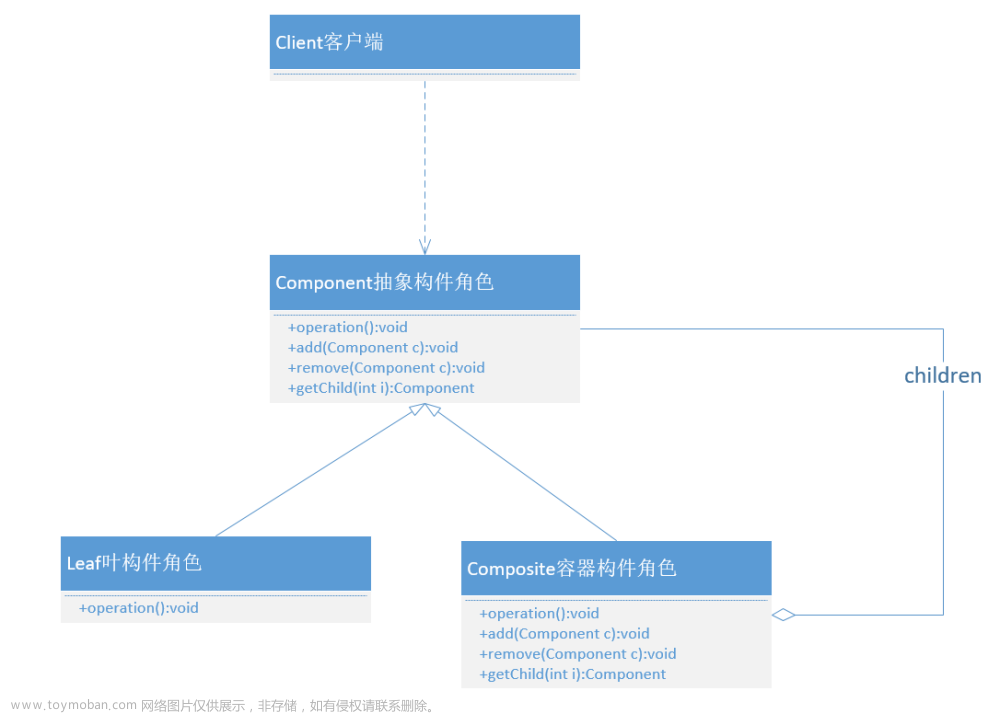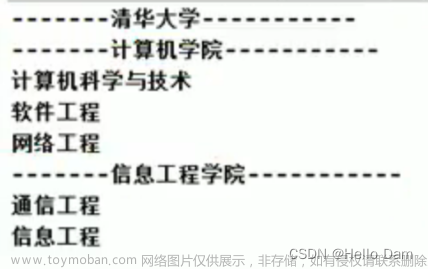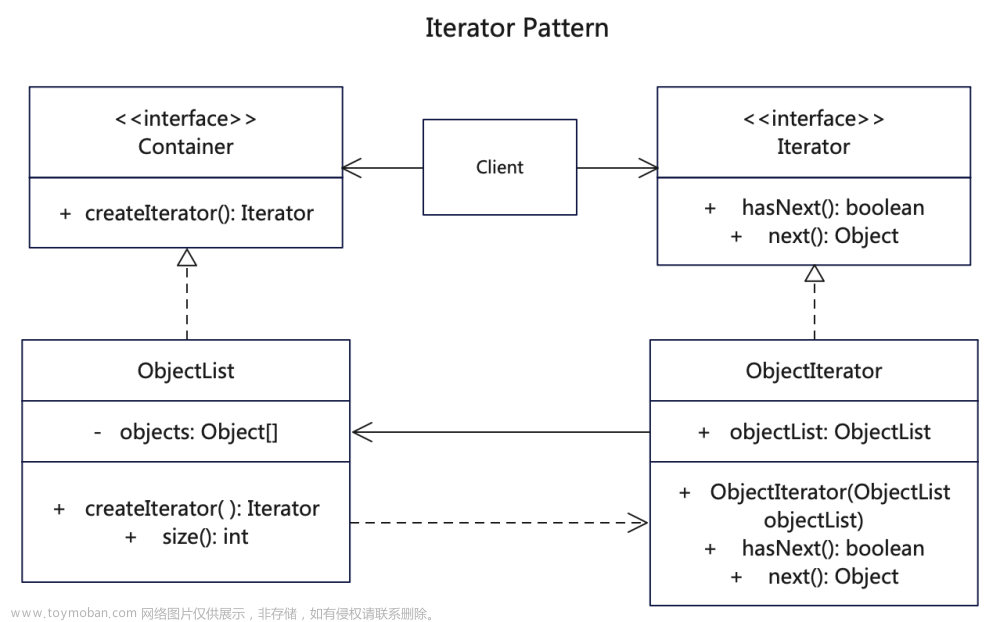设计模式浅析(十) ·设计模式之迭代器&组合模式
日常叨逼叨
java设计模式浅析,如果觉得对你有帮助,记得一键三连,谢谢各位观众老爷😁😁
案例
有两家门店,门店A呢只提供早餐,门店B呢只提供午餐,有一天这两家店铺想要进行合并,一起做大做强,再创辉煌。
合并后呢,对于菜单的定制存在了一定的问题:
门店A的菜单采用了ArrayList进行存储,但是门店B的菜单之前是采用了数组进行存储,那么在合并之后,对于服务员来说,怎么才能将菜单展示出来,是一件比较头疼的事情
旧的门店A的菜单构成:
/**
* @version 1.0
* @Author jerryLau
* @Date 2024/2/29 14:37
* @注释 A餐馆的馅饼菜单
*/
public class PanCakeMenu {
private ArrayList menuItems;
public PanCakeMenu() {
menuItems = new ArrayList<>();
addItem("K&B PanCake", "PanCake with eggs and beef", true, 18.0);
addItem("normal PanCake", "PanCake with eggs", true, 10.0);
addItem("blueberry PanCake", "PanCake with blue and cheese", false, 13.0);
}
private void addItem(String name, String disc, boolean vegetarian, double price) {
menuItems.add(new MenuItem(name, disc, vegetarian, price));
}
public ArrayList getMenuItems() {
return menuItems;
}
}
旧的门店B的菜单组成:
/**
* @version 1.0
* @Author jerryLau
* @Date 2024/2/29 14:37
* @注释 B餐馆的午餐菜单
*/
public class LunchMenu {
static final Integer MAX_VALUE = 3;
int index = 0;
private MenuItem[] menuItems;
public LunchMenu() {
menuItems = new MenuItem[MAX_VALUE];
addItem("single lunch", "hot dog with coke", true, 18.0);
addItem("soup", "soup with cake for lunch", true, 19.0);
addItem("Tomato and egg rice bowl", "rice with Tomato and egg for lunch", true, 21.0);
}
private void addItem(String name, String disc, boolean vegetarian, double price) {
if (menuItems.length > MAX_VALUE) {
System.out.println("menu is full, not allowed to insert !");
} else {
menuItems[index] = new MenuItem(name, disc, vegetarian, price);
index++;
}
}
public MenuItem[] getMenuItems() {
return menuItems;
}
}
那么对于服务员来说,在合并门店之后,如果实现简单的菜单组合,服务员代码可能如下
/**
* @version 1.0
* @Author jerryLau
* @Date 2024/2/29 15:01
* @注释 合并后的B餐厅的waiter
*/
public class Waiter {
private PanCakeMenu panCakeMenu;
private LunchMenu lunchMenu;
public Waiter(PanCakeMenu panCakeMenu, LunchMenu lunchMenu) {
this.panCakeMenu = panCakeMenu;
this.lunchMenu = lunchMenu;
}
public void showMenu() {
//展示菜单
ArrayList menuItems = panCakeMenu.getMenuItems();
MenuItem[] menuItems1 = lunchMenu.getMenuItems();
for (int i = 0; i < menuItems.size(); i++) {
MenuItem a = (MenuItem) menuItems.get(i);
System.out.println(a.toString());
}
for (int i = 0; i < menuItems1.length; i++) {
MenuItem MenuItem = menuItems1[i];
System.out.println(MenuItem.toString());
}
}
}
运行结果:
breakfast-
MenuItem{name=‘K&B PanCake’, disc=‘PanCake with eggs and beef’, vegetarian=true, price=18.0}
MenuItem{name=‘normal PanCake’, disc=‘PanCake with eggs’, vegetarian=true, price=10.0}
MenuItem{name=‘blueberry PanCake’, disc=‘PanCake with blue and cheese’, vegetarian=false, price=13.0}
lunch-
MenuItem{name=‘single lunch’, disc=‘hot dog with coke’, vegetarian=true, price=18.0}
MenuItem{name=‘soup’, disc=‘soup with cake for lunch’, vegetarian=true, price=19.0}
MenuItem{name=‘Tomato and egg rice bowl’, disc=‘rice with Tomato and egg for lunch’, vegetarian=true, price=21.0}
虽然呢,对于服务员来说,貌似实现了这个showmenu()这个功能,但是如果后期再加入一个门店,是不是又得写一个循环去进行第三家门店菜单的遍历?
那么有没有办法进行优化一些呢?
我们来进行分析一下:
-
要遍历早餐项,我们需要使用ArrayList的
size()和get()方法 -
要遍历午餐项,我们需要使用数组的
length字段和中括号[] -
现在我们创建一个对象,将它称为迭代器(Iterator),利用它来封装“遍历集合内的每个对象的过程”。先让我们在ArrayList上试试:
Iterator iterator1 = panCakeMenu.createIterator(); while (iterator1.hasNext()) { System.out.println(iterator1.next().toString()); } -
然后在数组上试一试:
MealIterator iterator = lunchMenu.createIterator();
while (iterator.hasNext()){
System.out.println(iterator.next().toString());
}
那么我们创建一个MealIterator迭代器,暂时为lunchMenu服务
/**
* @version 1.0
* @Author jerryLau
* @Date 2024/2/29 15:11
* @注释 MealIterator
*/
public class MealIterator implements Iterator {
private MenuItem[] menuItems;
private int index = 0;
public MealIterator(MenuItem[] menuItems) {
this.menuItems = menuItems;
}
@Override
public boolean hasNext() {
if (menuItems.length <= index||menuItems[index]==null) {
return false;
} else
return true;
}
@Override
public Object next() {
MenuItem menuItem = menuItems[index];
index++;
return menuItem;
}
@Override
public void remove() {
if (index < 0) {
throw new IllegalArgumentException("list is empty,no element can be removed !");
}
if (menuItems[index - 1] != null) {
for (int i = index - 1; i < (menuItems.length - 1); i++) {
menuItems[i] = menuItems[i + 1];
}
menuItems[index - 1] = null;
}
}
}
使用上述的迭代器,重构菜单
/**
* @version 1.0
* @Author jerryLau
* @Date 2024/2/29 14:37
* @注释 B餐馆的午餐菜单
*/
public class LunchMenu {
static final Integer MAX_VALUE = 5;
int index = 0;
private MenuItem[] menuItems;
public LunchMenu() {
menuItems = new MenuItem[MAX_VALUE];
addItem("single lunch", "hot dog with coke", true, 18.0);
addItem("soup", "soup with cake for lunch", true, 19.0);
addItem("Tomato and egg rice bowl", "rice with Tomato and egg for lunch", true, 21.0);
}
private void addItem(String name, String disc, boolean vegetarian, double price) {
if (menuItems.length > MAX_VALUE) {
System.out.println("menu is full, not allowed to insert !");
} else {
menuItems[index] = new MenuItem(name, disc, vegetarian, price);
index++;
}
}
public MealIterator createIterator() {
return new MealIterator(menuItems);
}
}
相应的,服务员类也进行重构
/**
* @version 1.0
* @Author jerryLau
* @Date 2024/2/29 15:01
* @注释 合并后的B餐厅的waiter
*/
public class Waiter {
private PanCakeMenu panCakeMenu;
private LunchMenu lunchMenu;
public Waiter(PanCakeMenu panCakeMenu, LunchMenu lunchMenu) {
this.panCakeMenu = panCakeMenu;
this.lunchMenu = lunchMenu;
}
public void showMenu() {
//展示菜单
Iterator iterator1 = panCakeMenu.createIterator();
MealIterator iterator = lunchMenu.createIterator();
System.out.println("breakfast-");
showMenu(iterator1);
System.out.println("lunch-");
showMenu(iterator);
}
public void showMenu(Iterator iterator) {
while (iterator.hasNext()) {
System.out.println(iterator.next().toString());
}
}
}
这个选代器让服务员能够从具体类的实现中解耦。她不需要知道菜单是使用数组、ArrayList,还是便利贴来实现。她只关心她能够取得选代器。
但是对于服务员来说,他还持有两个接口的具体实现类,有点违背了我们面向接口编程而不是面向接口的实现编程这一原则,我们在重构一下代码。
- 创建Menu接口
/**
* @version 1.0
* @Author jerryLau
* @Date 2024/2/29 14:37
* @注释 menu 公共接口
*/
public interface Menu {
Iterator createIterator();
}
- 让PanCakeMenu和LunchMenu实现接口
/**
* @version 1.0
* @Author jerryLau
* @Date 2024/2/29 14:37
* @注释 B餐馆的午餐菜单
*/
public class LunchMenu implements Menu{
static final Integer MAX_VALUE = 5;
int index = 0;
private MenuItem[] menuItems;
public LunchMenu() {
menuItems = new MenuItem[MAX_VALUE];
addItem("single lunch", "hot dog with coke", true, 18.0);
addItem("soup", "soup with cake for lunch", true, 19.0);
addItem("Tomato and egg rice bowl", "rice with Tomato and egg for lunch", true, 21.0);
}
private void addItem(String name, String disc, boolean vegetarian, double price) {
if (menuItems.length > MAX_VALUE) {
System.out.println("menu is full, not allowed to insert !");
} else {
menuItems[index] = new MenuItem(name, disc, vegetarian, price);
index++;
}
}
public Iterator createIterator() {
return new MealIterator(menuItems);
}
}
- 让服务员持有接口Menu
/**
* @version 1.0
* @Author jerryLau
* @Date 2024/2/29 15:01
* @注释 合并后的B餐厅的waiter
*/
public class Waiter {
private Menu panCakeMenu;
private Menu lunchMenu;
public Waiter(Menu panCakeMenu, Menu lunchMenu) {
this.panCakeMenu = panCakeMenu;
this.lunchMenu = lunchMenu;
}
public void showMenu() {
//展示菜单
Iterator iterator1 = panCakeMenu.createIterator();
Iterator iterator = lunchMenu.createIterator();
System.out.println("breakfast-");
showMenu(iterator1);
System.out.println("lunch-");
showMenu(iterator);
}
public void showMenu(Iterator iterator) {
while (iterator.hasNext()) {
System.out.println(iterator.next().toString());
}
}
}
你可能会奇怪,为什么我们不使用Java的Iterator接口呢–我们之所以这么做,是为了要让你了解如何从头创建一个迭代器。现在目的达到了,如果再有店铺合并,可以使用java的Iterator接口。
迭代器模式
Java设计模式中的迭代器模式介绍
迭代器模式是一种行为型设计模式,它提供了一种方法来顺序访问一个聚合对象中的各个元素,而无需知道或暴露该对象的内部表示。在Java中,迭代器模式是通过java.util.Iterator接口来实现的。
元素
迭代器模式涉及以下几个主要的元素:
-
迭代器(Iterator):这是一个接口或抽象类,它定义了访问和遍历聚合对象中的元素的方法。在Java中,这通常是一个名为
iterator()的方法,它返回一个实现了Iterator接口的对象。 - 具体迭代器(ConcreteIterator):这是迭代器接口的具体实现。它负责遍历聚合对象中的元素,并提供了获取下一个元素、检查是否还有更多元素等方法。
-
聚合(Aggregate):这是一个接口或抽象类,它定义了创建迭代器对象的方法。在Java中,这通常是一个名为
iterator()的方法。 - 具体聚合(ConcreteAggregate):这是聚合接口的具体实现。它实现了创建迭代器对象的方法,并返回与聚合对象相关联的具体迭代器。
优缺点
优点:
- 简化遍历:迭代器模式提供了一种简单的方式来遍历聚合对象中的元素,而无需了解聚合对象的底层表示。
- 多种遍历方式:通过实现不同的迭代器类,可以为同一个聚合对象提供多种遍历方式。
- 封装性:使用迭代器模式,客户端代码只需要知道如何使用迭代器,而无需关心聚合对象的内部实现。
缺点:
- 增加类的数量:由于迭代器模式将存储数据和遍历数据的职责分离,每个聚合类可能需要对应一个迭代器类,这可能会增加系统的复杂性。
- 遍历效率:对于简单的聚合对象(如数组或有序列表),使用迭代器进行遍历可能比直接访问元素更加繁琐和效率低下。
适用场景
迭代器模式通常适用于以下场景:
- 需要遍历聚合对象的场景,而又不希望客户端代码了解聚合对象的底层表示。
- 需要为聚合对象提供多种遍历方式的场景。
- 需要统一遍历接口的场景,以简化客户端代码。
- 在Java中,
java.util.Iterator接口就是迭代器模式的实现。当你有一个集合(如List、Set等)并想要遍历其中的元素时,你可以使用迭代器。
正当我们觉得这样很周全时,突然又有一个新的需求,店家B想在午餐的菜单中添加一种午后甜点的“子菜单”
如果我们能让甜点菜单变成餐厅菜单集合的一个元素,那该有多好。但是根据现在的实现,根本做不到。
上述需求类似于这样:

那么我们不得不考虑用一些新的设计,因为我们需要表现菜单、嵌套子菜单和菜单项,我们很自然地采用树形结构以便符合这样的需求
所以,在我们的新设计中,真正需要些什么呢?
我们需要某种树形结构,可以容纳菜单、子菜单和菜单项。
我们需要确定能够在每个菜单的各个项之间游走,而且至少要像现在用迭代器一样方便。
我们也需要能够更有弹性地在菜单项之间游走。比方说,可能只需要遍历甜点菜单,或者可以遍历餐厅的整个菜单(包括甜点菜单在内)
没错,我们要介绍另一个模式解决这个难题。我们并没有放弃迭代器–它仍然是我们解决方案中的一部分–然而,管理菜单的问题已经到了一个迭代器无法解决的新维度。所以,我们将倒退几步,改用组合模式(Composite Pattern)来实现这一部分。
对于这个模式,我们不打算深入探讨,只在这里提出它的正式定义:
组合模式
**定义:**组合模式允许你将对象组合成树形结构来表现“整体/部分”层次结构。组合能让客户以一致的方式处理个别对象以及对象组合。
类图:

我们要如何在菜单上应用组合模式呢?一开始,我们需要创建一个组件接口来作为菜单和菜单项的共同接口,让我们能够用统一的做法来处理菜单和菜单项。换句话说,我们可以针对菜单或菜单项调用相同的方法。
首先可以创建菜单组件
public abstract class MenuComponent {
//操作 range start
public void add(MenuComponent menuComponent) {
throw new UnsupportedOperationException();
}
public void remove(MenuComponent menuComponent) {
throw new UnsupportedOperationException();
}
public MenuComponent getChild(int i) {
throw new UnsupportedOperationException();
}
//操作 range end
//基本属性 range start
public String getName() {
throw new UnsupportedOperationException();
}
public String getDescription() {
throw new UnsupportedOperationException();
}
public double getPrice() {
throw new UnsupportedOperationException();
}
public boolean isVegetarian() {
throw new UnsupportedOperationException();
}
public void print() {
throw new UnsupportedOperationException();
}
//基本属性 range end
}
然后创建菜单项继承菜单组件
public class MenuItem extends MenuComponent {
private String name;
private String description;
private double price;
private boolean isVegetarian;
public MenuItem(String name, String description, double price, boolean isVegetarian) {
this.name = name;
this.description = description;
this.price = price;
this.isVegetarian = isVegetarian;
}
@Override
public String getName() {
return name;
}
@Override
public String getDescription() {
return description;
}
@Override
public double getPrice() {
return price;
}
@Override
public boolean isVegetarian() {
return isVegetarian;
}
@Override
public void print() {
System.out.println(" " + getName() + (isVegetarian() ? "(N)" : "(Y)") + " " + getDescription() + " " + getPrice() + " ");
}
}
同样创建菜单,也是继承自菜单组件
public class Menu extends MenuComponent {
List<MenuComponent> menuComponents = new ArrayList<MenuComponent>();
private String name;
private String description;
public Menu(String name, String description) {
this.name = name;
this.description = description;
}
@Override
public void add(MenuComponent menuComponent) {
menuComponents.add(menuComponent);
}
@Override
public void remove(MenuComponent menuComponent) {
menuComponents.remove(menuComponent);
}
@Override
public MenuComponent getChild(int i) {
return menuComponents.get(i);
}
@Override
public String getName() {
return name;
}
@Override
public String getDescription() {
return description;
}
@Override
public void print() {
System.out.println(" " + getName()+" " + getDescription());
System.out.println("---------------------------");
Iterator<MenuComponent> iterator = menuComponents.iterator();
while (iterator.hasNext()) {
MenuComponent next = iterator.next();
next.print();
}
}
}
那么对于服务员来说,可以进行以下修改
public class Waiter {
MenuComponent allMenus;
public Waiter(MenuComponent allMenus) {
this.allMenus = allMenus;
}
public void printMenu() {
allMenus.print();
}
}
创建测试类
public class MenuTestDriver {
public static void main(String[] args) {
MenuComponent menuComponentA = new Menu("PANCAKE HOUSE MENU", "Breakfast");
MenuComponent menuComponentB = new Menu("LUNCH MENU", "Lunch");
MenuComponent innerMenu = new Menu("LUNCH inner MENU", "Dessert of Lunch ");
MenuComponent allMenus = new Menu("ALL MENUS", "All menus combined");
allMenus.add(menuComponentA);
allMenus.add(menuComponentB);
menuComponentB.add(new MenuItem("蛋炒饭", "蛋炒饭:米饭,鸡蛋", 15.0, false));
menuComponentB.add(innerMenu);
innerMenu.add(new MenuItem("甜点", "饭后甜点", 1.5, true));
innerMenu.add(new MenuItem("水果", "饭后水果", 5.0, true));
Waiter waiter = new Waiter(allMenus);
waiter.printMenu();
}
}
运行结果

至此,我们通过了组合模式,实现了菜单的管理
下面我们一起来总结以下组合模式相关的内容
元素
组合模式主要包含三个要素:
- 抽象根节点(Component):定义系统各层次对象的共有方法和属性,可以预先定义一些默认行为和属性。在抽象根节点中,通常会定义访问及管理其子构件的方法,如增加子节点、删除子节点、获取子节点等。
- 叶子节点(Leaf):叶子节点对象,其下再无分支,是系统层次遍历的最小单位。在组合结构中,叶子节点没有子节点,它实现了在抽象根节点中定义的行为。
- 树枝节点(Composite):定义树枝节点的行为,存储子节点,组合树枝节点和叶子节点形成一个树形结构。树枝节点可以包含树枝节点,也可以包含叶子节点,它其中有一个集合可以用于存储子节点,实现了在抽象根节点中定义的行为。在其业务方法中可以递归调用其子节点的业务方法。
优缺点
组合模式的优点主要有:
- 简化客户端代码:组合模式使得客户端代码可以一致地处理单个对象和组合对象,无须关心自己处理的是单个对象还是组合对象。
- 增加新的构件方便:在组合体内加入新的对象很容易,客户端不会因为加入了新的对象而更改源代码。
- 开闭原则:组合模式符合开闭原则,对扩展开放,对修改封闭。
- 灵活的解决方案:为树形结构的面向对象实现提供了一种灵活的解决方案,通过叶子对象和容器对象的递归组合可以形成复杂的树形机构,但对树形结构的控制却很简单。
然而,组合模式也存在一些缺点:
- 违反依赖倒置原则:在使用组合模式时,其叶子和树枝的声明都是实现类,而不是接口,这在一定程度上违反了依赖倒置原则。
- 设计较复杂:客户端需要花更多时间理清类之间的层次关系。
- 不容易限制容器中的构件:在组合模式中,不容易限制容器中可以包含的构件类型。
代码相关代码可以参考 代码仓库🌐文章来源:https://www.toymoban.com/news/detail-847910.html
ps:本文原创,转载请注明出处文章来源地址https://www.toymoban.com/news/detail-847910.html
到了这里,关于设计模式浅析(十) ·设计模式之迭代器&组合模式的文章就介绍完了。如果您还想了解更多内容,请在右上角搜索TOY模板网以前的文章或继续浏览下面的相关文章,希望大家以后多多支持TOY模板网!












